Have you ever marveled at the growth of oak trees, from their humble beginnings as tiny acorns to their towering presence in the landscape?
The growth cycle of oak trees is a fascinating journey that starts with a small acorn falling to the forest floor. If undisturbed, the acorn will germinate and sprout in the spring, sending roots as deep as five feet in their first year of growth. However, not all acorns sprout, and those that do face challenges like being eaten by birds or animals or competing with nearby plants for resources.
As the oak tree continues to grow, it develops strong limbs that provide perches and shelter for various creatures. Oaks are cultivated for their lumber, which is used for shipbuilding, furniture, and more. They are also popular in landscaping due to their majestic presence.
Acorns, the seeds of oak trees, have versatile uses beyond tree growth. They can be used as animal feed or for various other purposes in different industries.
For those interested in growing their own oak tree, the process begins with collecting acorns in the fall. After soaking them in water, they need to be stratified in the refrigerator for a month before planting them in pots or directly into the ground. It takes many years for an oak tree to reach full size and start producing its own acorns, but the reward is a lasting legacy.
Key Takeaways:
- The growth cycle of oak trees starts with a small acorn falling to the forest floor.
- Germination of acorns marks the beginning of oak tree growth.
- Early growth stages of oak saplings require care and face challenges.
- Oaks develop strong limbs that provide perches and shelter for various creatures.
- Oak trees are cultivated for their lumber and utilized in landscaping.
The Germination of Acorns: A Start to Oak Tree Growth
When a mature acorn falls to the forest floor, it holds within it the potential for a magnificent oak tree to grow. The germination process is the first step in this journey of oak tree growth. As the acorn settles into the ground, aided by gravity and the elements, its outer shell protects the precious life inside.
The acorn requires specific conditions to begin germination, including moisture, warmth, and oxygen. Once these conditions are met, the acorn absorbs water, causing it to swell and soften. This sets the stage for the emergence of the primary root, called the radicle. The radicle pushes through the softened shell, anchoring the acorn in the soil, and begins to absorb nutrients from its surroundings.
The next stage of germination is the emergence of the shoot, which will eventually grow into the oak tree’s trunk and branches. The shoot breaks through the soil’s surface, reaching towards the sunlight. As it grows, tiny green leaves unfurl, harnessing the power of photosynthesis to convert sunlight into energy for the growing oak tree.
Germination Process:
- Mature acorn falls to the forest floor
- Acorn absorbs water and swells
- Radicle emerges, anchoring the acorn in the soil
- Shoot breaks through the soil’s surface
- Leaves unfurl, harnessing sunlight for energy
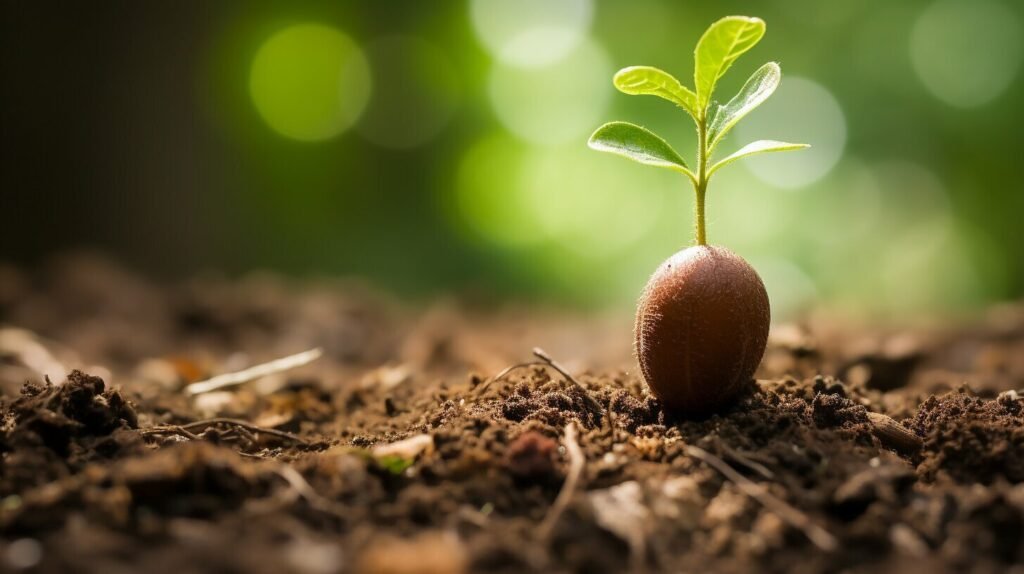
The germination of acorns is a remarkable process that marks the beginning of an oak tree’s growth cycle. From this small, humble start, a mighty oak tree will eventually take root and flourish, providing shelter, sustenance, and beauty to the world around it.
Nurturing Saplings: Care and Challenges in Early Growth
As oak saplings emerge from the ground, they require careful attention and nurturing to ensure their healthy growth. These young trees are delicate and vulnerable, facing various challenges in their early stages of development.
One of the key aspects of sapling care is providing them with the right amount of water. While young oak trees need moisture to thrive, overwatering can lead to root rot and hinder their growth. It’s crucial to strike a balance and water them appropriately, keeping the soil slightly damp without causing waterlogged conditions.
Another important factor in the care of oak saplings is protection from external threats. Deer and other animals can cause significant damage by browsing on the tender leaves and shoots. To safeguard the young trees, it is advisable to install deer fencing or use repellents to deter these animals.
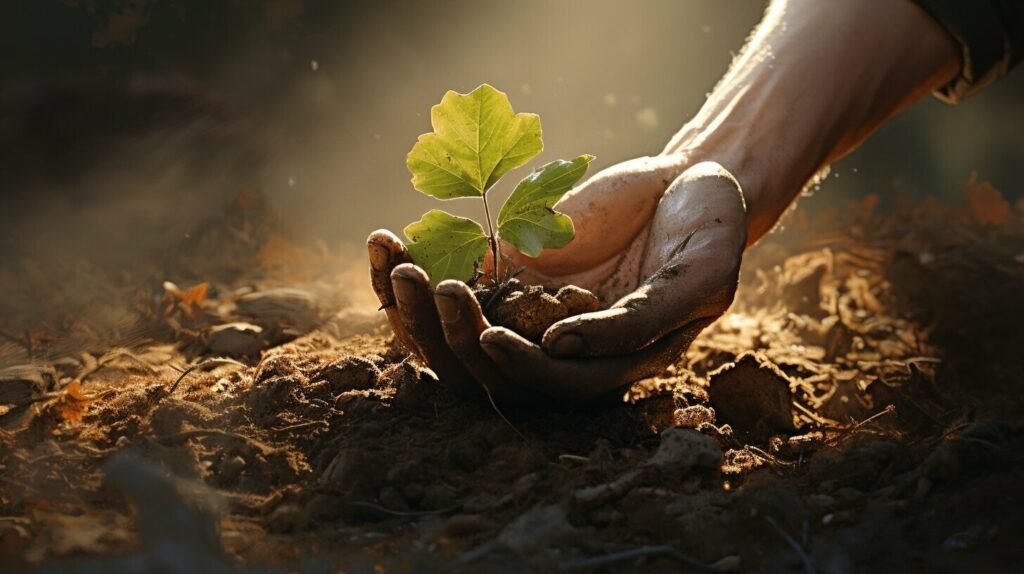
Table 1: Common Challenges in Oak Sapling Growth
| Challenge | Solution |
|---|---|
| Poor soil quality | Amend soil with organic matter and fertilizer |
| Competition from weeds | Regular weeding and mulching to suppress weed growth |
| Inadequate sunlight | Prune surrounding vegetation to allow more sunlight to reach the saplings |
Nurturing oak saplings also involves regular monitoring for any signs of disease or insect infestation. Identifying these issues early on allows for prompt treatment and prevents further damage. A certified arborist can offer expert advice and assistance in diagnosing and treating common sapling ailments.
“The care and attention given to oak saplings in their early growth stages lay the foundation for their future strength and resilience.”
With proper care and consideration, oak saplings can overcome the challenges they face and grow into mighty trees that provide shade, beauty, and habitat for numerous species. The love and dedication invested in their early growth stages contribute to the enduring legacy of these remarkable trees.
The Strength of Limbs: Creating Habitat and Shelter
As oak trees continue to grow, their branches become sturdy and create valuable habitats and shelters for wildlife. These strong limbs provide perches for birds, allowing them to rest, build nests, and raise their young. Squirrels also take advantage of the tree’s branches, using them as highways to travel through the canopy and to access their food sources. The intricate network of branches and foliage offers protection and refuge to a variety of small animals, including insects, rodents, and even smaller plants that thrive in the shade.
The sprawling branches of mature oak trees not only create habitats, but they also offer shelter from the elements. The dense foliage provides a natural canopy that shields animals from rain, snow, and the scorching sun. Birds seek refuge within the branches during storms, finding safety and protection from strong winds and predators. The presence of oak trees in an area can significantly impact the biodiversity, attracting a wide range of wildlife and supporting thriving ecosystems.
Moreover, the strength of oak tree limbs makes them ideal for nesting platforms, with many bird species preferring to build their nests in the sturdy branches. The elevated position offers increased visibility and protection from ground-based predators. Additionally, the large, strong limbs provide a safe haven for larger animals, such as squirrels and raccoons, creating dens or resting spots where they can seek shelter from harsh weather conditions.
The Vital Role of Deadwood
Even after oak trees die or lose branches, they continue to play a vital role in the ecosystem as deadwood. Deadwood provides habitats for a variety of organisms, including beetles, fungi, and plants. It becomes a valuable food source for wood-boring insects, which in turn become a food source for birds and other animals. Decay fungi, known as saproxylic fungi, break down the deadwood, further enriching the soil and contributing to the nutrient cycle of the forest. As the deadwood decomposes, it creates cavities and hollows that serve as nesting sites for a diverse range of animals, including owls, bats, and woodpeckers.
| Species | Common Name | Status |
|---|---|---|
| Quercus alba | White Oak | Least Concern |
| Quercus rubra | Northern Red Oak | Least Concern |
| Quercus velutina | Black Oak | Least Concern |
Overall, the strength of oak tree limbs not only adds to the majesty and beauty of these grand trees but also provides essential habitats and shelters for a wide array of wildlife. From birds and squirrels to insects and fungi, the branches of oak trees contribute to the flourishing biodiversity of our natural habitats.

Oak trees have long been valued for their wood, which is highly sought-after for a variety of applications, including shipbuilding, furniture, and more. The strong and durable nature of oak wood makes it ideal for construction projects that require strength and longevity. It is also resistant to rot and insect damage, further enhancing its desirability.

In addition to its use in construction, oak wood is prized for its appearance. Furniture makers appreciate its beautiful grain patterns and rich color, which add a touch of elegance to any piece. Oak flooring is a popular choice for its durability and timeless appeal.
Landscapers also recognize the value of oak trees. Their large, spreading canopies provide shade and create a sense of grandeur in parks, gardens, and public spaces. Oak trees are often used as focal points in landscaping designs, adding beauty and character to outdoor spaces.
Benefits of Using Oak Wood:
- Strength and durability
- Resistance to rot and insect damage
- Beautiful grain patterns and rich color
- Timeless appeal
“Oak wood is a versatile material that can be used in various applications, from construction to furniture making. Its durability and aesthetic qualities make it a popular choice among craftsmen and homeowners alike.”
Whether it’s for building a sturdy ship or creating a stunning piece of furniture, oak trees have proven to be a valuable resource. Their growth cycle, from tiny acorn to mighty oak, yields not only majestic trees but also a versatile and enduring material.
| Application | Benefits |
|---|---|
| Shipbuilding | Strength, durability, resistance to rot |
| Furniture | Beautiful grain patterns, rich color |
| Landscaping | Shade, grandeur, focal points |
Versatile Acorns: Beyond Tree Growth
Did you know that oak tree acorns serve more than just the purpose of tree propagation? These humble nuts have a variety of uses beyond growing mighty oaks. From animal feed to culinary creations, acorns have been utilized throughout history for their unique qualities.
One fascinating way acorns are used is in animal feed. Rich in carbohydrates and fats, acorns provide a valuable food source for livestock and wildlife. The high energy content of acorns makes them an excellent supplement for grazing animals during harsh winter months when food may be scarce. Additionally, acorns are known to attract certain animals such as deer, squirrels, and birds, creating opportunities for wildlife observation and conservation.
Not only do acorns serve as a nutritious meal for animals, but they can also be transformed into a culinary delight for humans. In some cultures, acorns have been harvested and processed into flour to make bread, cakes, and other baked goods. The nutty flavor and versatility of acorn flour add a unique touch to traditional recipes and create a connection to ancestral culinary traditions.
As we appreciate the valuable role that oak trees play in our ecosystems, it is important to recognize the multi-faceted nature of their acorns. Whether they are providing sustenance for animals or inspiring culinary creativity, acorns remind us of the interconnectedness of nature and the diverse ways in which we can benefit from its offerings.
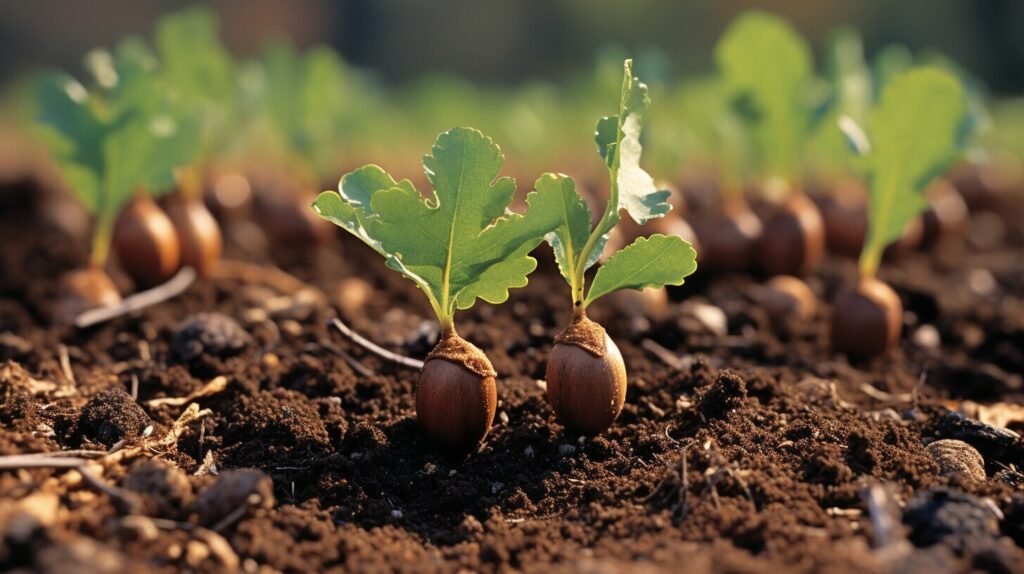
| Component | Value |
|---|---|
| Protein | 6% |
| Fats | 40% |
| Carbohydrates | 50% |
| Fiber | 4% |
Growing Your Own Oak Tree: A Step-by-Step Guide
If you want to witness the remarkable growth of an oak tree firsthand, you can try growing your own. It’s a rewarding and educational experience that allows you to appreciate the magic of nature. Follow these simple steps to start your own oak tree journey:
- Collecting Acorns: In the fall, search for healthy acorns that have dropped from oak trees. Choose ones with intact caps and no visible signs of damage or disease. Acorns from different oak species may have different growth characteristics, so it’s best to collect acorns from local oak trees.
- Preparing Acorns: Soak the collected acorns in water for a day to remove any impurities or pests. Afterward, gently dry them with a paper towel.
- Stratifying Acorns: Place the dried acorns in a plastic bag with moist sand or vermiculite. Keep the bag in the refrigerator for about a month. This cold stratification process imitates the natural winter conditions that acorns need to germinate.
- Planting Acorns: After stratification, fill a pot or choose a suitable location in the ground for planting. Make sure the soil is well-draining. Plant the acorns about an inch deep, cover them with soil, and water thoroughly.
- Nurturing the Seedlings: Keep the soil consistently moist but not waterlogged. Place the pot or ensure the planted acorns receive partial shade and protection from strong winds. Remember, patience is key as oak trees grow slowly.

As your oak tree seedlings grow, they will require ongoing care and protection from pests and diseases. Monitor their growth, provide water during dry spells, and mulch around the base of the trees to help retain moisture and suppress weeds.
With time and patience, your oak tree will flourish, becoming a symbol of strength and beauty. Remember, every oak tree has its own unique growth pattern and timeline, so enjoy the process and embrace the wonders of nature.
| Step | Description |
|---|---|
| 1 | Collecting Acorns |
| 2 | Preparing Acorns |
| 3 | Stratifying Acorns |
| 4 | Planting Acorns |
| 5 | Nurturing the Seedlings |
The Journey to Maturity: Oak Tree Aging
Just like any other living organism, oak trees go through the process of aging as they reach maturity. Over time, the majestic oak tree undergoes subtle changes in its structure and appearance, reflecting the passage of years and the wisdom gained through them. As an oak tree ages, its trunk thickens, and its branches spread out, creating a strong and sturdy frame that withstands the test of time.
One of the most distinctive signs of an aging oak tree is the development of deep furrows and ridges on its bark. These natural formations, known as fissures, not only add character to the tree but also provide protection against external elements. The bark of an older oak tree becomes rougher, serving as a shield against harsh weather conditions and potential predators.
As an oak tree reaches its mature stage, its branches become more gnarled and twisted, showcasing the unique beauty that comes with age. These branches provide a haven for numerous species of birds, squirrels, and insects, creating a thriving ecosystem within the tree’s embrace. The aging oak tree becomes a sanctuary, supporting and sustaining a diverse range of life forms.
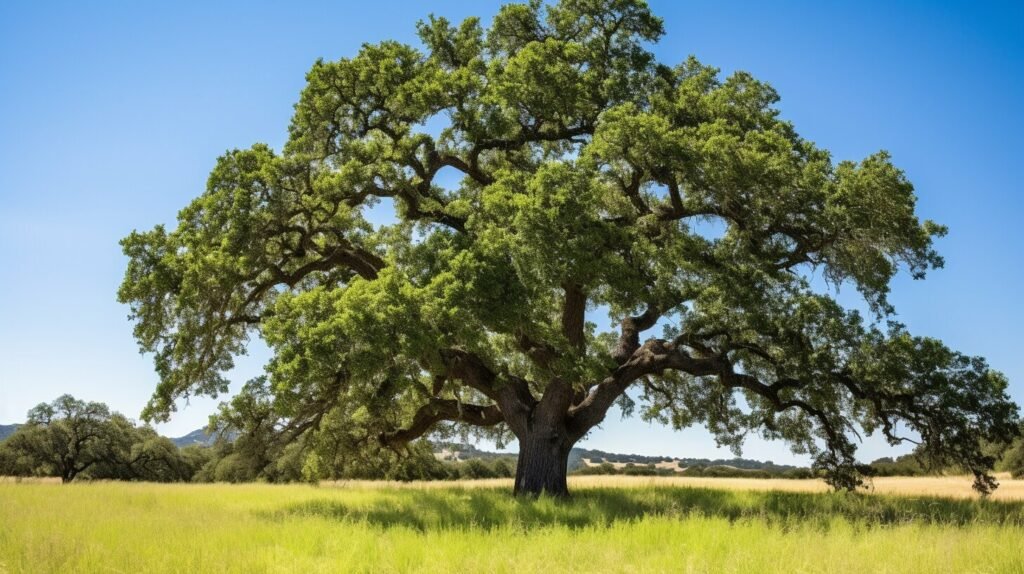
In conclusion, the journey from acorn to mighty oak is a testament to the resilience and longevity of these remarkable trees. Oak trees age gracefully, acquiring a majestic presence that commands admiration and respect. As they grow, their branches extend like open arms, supporting life and providing habitat for a variety of creatures. The aging process, marked by the development of fissures and gnarled branches, contributes to the tree’s beauty and strength. Each mature oak tree becomes a living testament to the wonder and marvel of nature’s ability to transform a tiny acorn into a mighty, enduring symbol of life.
Patience Rewarded: Acorn Production and Tree Legacy
After years of growth, oak trees reach a stage where they produce their own acorns, leaving a lasting legacy for future generations. This remarkable achievement is the culmination of a complex process that starts with a tiny acorn and requires patience, resilience, and a touch of luck.
Once an acorn germinates, it develops into a sapling, facing numerous challenges along the way. Birds and animals may devour the acorns, while nearby plants compete for sunlight, water, and nutrients. However, the strong and determined saplings manage to establish themselves, putting down roots that delve as deep as five feet in their first year.
The growth of an oak tree is a marvel to behold. As it matures, it develops sturdy limbs that provide not only a majestic appearance but also serve as perches for birds and shelter for various creatures. The branches reach outwards, embracing a rich ecosystem within their leafy canopy. From squirrels to birds, a diverse array of wildlife finds solace and protection in the embrace of the mighty oak.
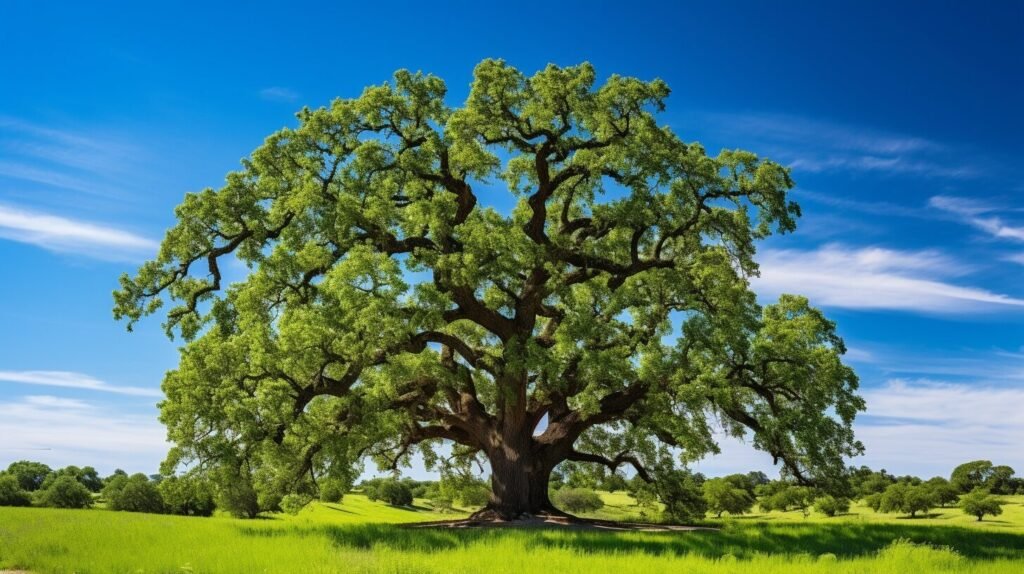
| Production of Acorns | Tree Legacy |
|---|---|
| A mature oak tree can produce thousands of acorns in a single year. | These acorns are the key to the oak tree’s legacy, as they ensure the continuation of the species and provide sustenance for wildlife. |
| Acorn production is not consistent from year to year, as oaks exhibit a phenomenon called mast seeding. This means that oak trees produce a bountiful harvest of acorns every few years, followed by years with significantly fewer acorns. | The cycle of mast seeding ensures that even during years of scarcity, a few surviving acorns have the opportunity to germinate and grow into new oaks, perpetuating the tree’s legacy. |
Acorns play a vital role not only in the life cycle of oak trees but also in the broader ecosystem. They serve as a valuable source of food for wildlife, including squirrels, deer, and birds. Some animals, such as blue jays, even play a crucial role in oak tree dispersal by burying acorns and inadvertently contributing to the tree’s proliferation.
As humans, we can also participate in the oak tree’s legacy by growing our own oak trees. Collecting acorns in the fall, soaking them in water, stratifying them in the refrigerator, and then planting them either in pots or directly into the ground can be a rewarding experience. However, it’s important to note that growing an oak tree requires patience, as it takes many years for it to reach full size and start producing its own acorns.
So next time you pass by an oak tree, take a moment to appreciate the journey it has undergone. From a tiny acorn to a mighty tree, its growth is a testament to the wonders of nature and the reward of patience. As we marvel at their beauty and strength, let us remember the oak tree’s ability to produce acorns and create a lasting legacy for generations to come.
Conclusion
The growth cycle of oak trees is truly a remarkable process, from the humble beginnings of a small acorn to the grandeur of a mature oak. It all starts with a tiny acorn, which falls to the forest floor and, if left undisturbed, germinates and sprouts in the spring. From there, the oak tree begins its journey of growth and development.
As the sapling emerges from the ground, it faces numerous challenges. Some acorns may not sprout at all, while others must contend with being eaten by birds and animals or competing with nearby plants for vital resources. But through resilience and determination, the oak tree perseveres, sending roots as deep as five feet in its first year.
As the oak tree matures, it grows strong limbs that not only provide a sturdy framework for its majestic crown but also serve as perches and shelter for various creatures. Oaks are not only admired for their beauty but also cultivated for their versatile wood. Used for shipbuilding, furniture, and more, oak lumber is highly valued for its strength and durability.
Even the acorns of oak trees have their purpose beyond tree growth. They can be used as animal feed or repurposed for various other uses. And for those who wish to witness the growth of an oak tree themselves, the process is simple. Collect acorns in the fall, soak them in water, stratify them in the refrigerator, and then plant them in pots or directly into the ground.
However, growing an oak tree requires patience. It takes many years for an oak tree to reach full size and start producing its own acorns. But the reward is worth the wait, as these magnificent trees contribute to their own tree legacy and continue the cycle of oak tree growth for future generations to marvel at.
FAQ
Q: How long does it take for an oak tree to reach full size?
A: It takes many years for an oak tree to reach full size and start producing its own acorns.
Q: What can acorns be used for?
A: Acorns can be used as animal feed and for various other purposes.
Q: How do I grow my own oak tree?
A: To grow your own oak tree, collect acorns in the fall, soak them in water, stratify them in the refrigerator for a month, and then plant them in pots or directly into the ground.
Source Links
- https://cms2.revize.com/revize/highlandscountyfl/departments/parks_and_recreation/docs/From_tiny_acorn_to_mighty_oak.pdf
- https://www.cavclosei.derby.sch.uk/wp-content/uploads/2022/02/t-l-53971-little-acorns-life-cycle-of-an-oak-tree-differentiated-reading-comprehension-activity_ver_1.pdf
- https://sciencing.com/the-life-cycle-of-an-acorn-seedling-into-a-tree-12486565.html




